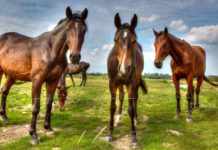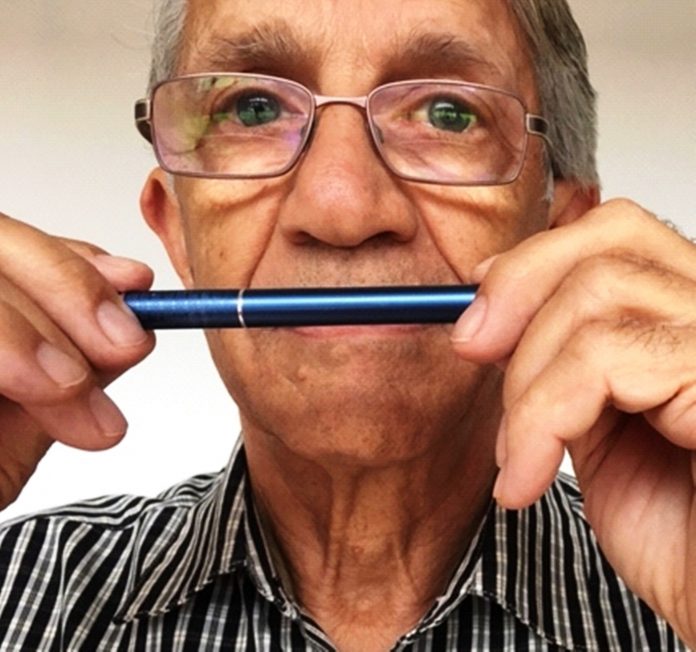
Berlin, Germany (Weltexpress). The recent spate of racehorse deaths at Santa Anita is not a disaster limited to one racetrack or one state. Racehorses die in all of the USA’s racing states. In fact, racehorses die worldwide, albeit less frequently than in the USA. Deaths are not even limited to flat racing. They occur in steeplechasing, harness racing, cross-country, endurance and many other horse sports. There may be a number of causes but my research tells me that the bit is one of them. It is possibly the one cause that is common to all disciplines. Bits throttle horses. Suffocation is notorious for causing sudden death in man. Frustratingly, the only way to confirm this in the horse is to make bit usage optional rather than mandatory. Until this is done, the hypothesis that bits kill horses cannot be tested. Fortunately, there is a solution to this ‘catch 22’ dilemma. Although a rule change cannot be justified on the grounds that the bit is already a proven cause of death, its removal can be justified on the grounds that it is a proven cause of many other serious problems. This evidence alone is reason enough for an update in the rules. Therefore, let’s make the rule change for these reasons. Even if the fatality figures did not decline, racing will still have taken a giant welfare and humanitarian step forward. A decline in the high prevalence of behavioural signs of pain, upper airway obstruction, soft palate suffocation and “bleeding” will, by themselves, support the continuance of racing’s social licence to operate.
The good news is that the bit is superfluous to horsemanship and a handicap easily removed. The benefits start on day one and bring life-enhancing experiences for both horse and rider. It solves a huge range of horsemanship problems, many of them predisposing to accidents that are potentially fatal. For example, in a long-term study, stumbling was a behavioral sign in a third of 66 bitted horses. By removing the bit, its prevalence was reduced by 68% (Cook and Kibler 2018). In the same group of bitted horses, none of which were racehorses, fear was noted in over two thirds. Removal of the bit reduced its prevalence by 87%.
Currently, the bit is mandated for most horse sports, worldwide. But since 1999, when the first peer-reviewed study of the bit was published, a burgeoning body of published research has found no evidence to justify its use and overwhelming evidence for its removal. The research has initiated a paradigm change for the horse world. In the last twenty years, hundreds of thousands of riders worldwide have chosen to switch their horses from bit to bit-free. They stand witness to the beneficial changes both they and their horses have experienced. These natural experiments conducted over the past 20 years by riders of all ages and experience, with horses of all types, age and breed, in most disciplines, and under a wide range of environmental conditions, represent a compelling proof of concept. Horses can be ridden bit-free with a pain-free rein-aid. Not once, in 20 years, has my attention been drawn to a horse-related accident attributed to the horse being bit-free.
As yet only one discipline, in one national federation, has updated its rules to allow bit-free competition. Three rousing cheers for dressage in Holland. The time has come for all disciplines and all countries to follow suit. Racing has nothing to lose and much to gain. For too long we have perpetuated a Bronze Age mistake (Cook 2019). Bitting a horse about to run is akin to muzzling a horse about to eat.
There is no need to ban the bit. A radical improvement in equine welfare and rider safety will be achieved in all horse sports by an update of the rules making bit use optional. Once this is done, as bit-free horses are likely to outperform bitted horses, bits will quietly disappear. In racing, the prevalence of pain-induced behavior, soft palate suffocation, ‘bleeding’ from the lungs, catastrophic breakdowns, and sudden death will, I predict, decline.
The horse’s throat is a crossroads for its digestive and respiratory tracts. Serving two functions, swallowing and breathing, a horse at liberty does this on an either/or basis; it cannot do both at the same time. In the wild, a horse gallops with a closed mouth, sealed lips and a stretched-out head and neck, as can be seen by searching ‘wild horses’ on many a YouTube video. Sadly, the first rules of racing were drawn-up nearly 300 years ago, when this fundamental of equine physiology was not recognized. Most of the subsequently formed horse sport disciplines, from dressage to Pony Club, followed racing’s rules and mandated use of the bit. As a result, during bitted performance, 99% of horses endure the simultaneous activation of two bodily systems whose functions are diametrically opposed. During physical exercise the respiratory system should be the dominant system (flight and fight responses) and only when eating should the digestive system be dominant (salivation and swallowing responses). The trouble is that the bit inappropriately activates the digestive system. Furthermore, bit induced pain engenders nervousness and anxiety. In any horse performing at or close to the upper limits of its physical ability, obstruction of the throat airway adds the noxiousness of suffocation and associated fear.
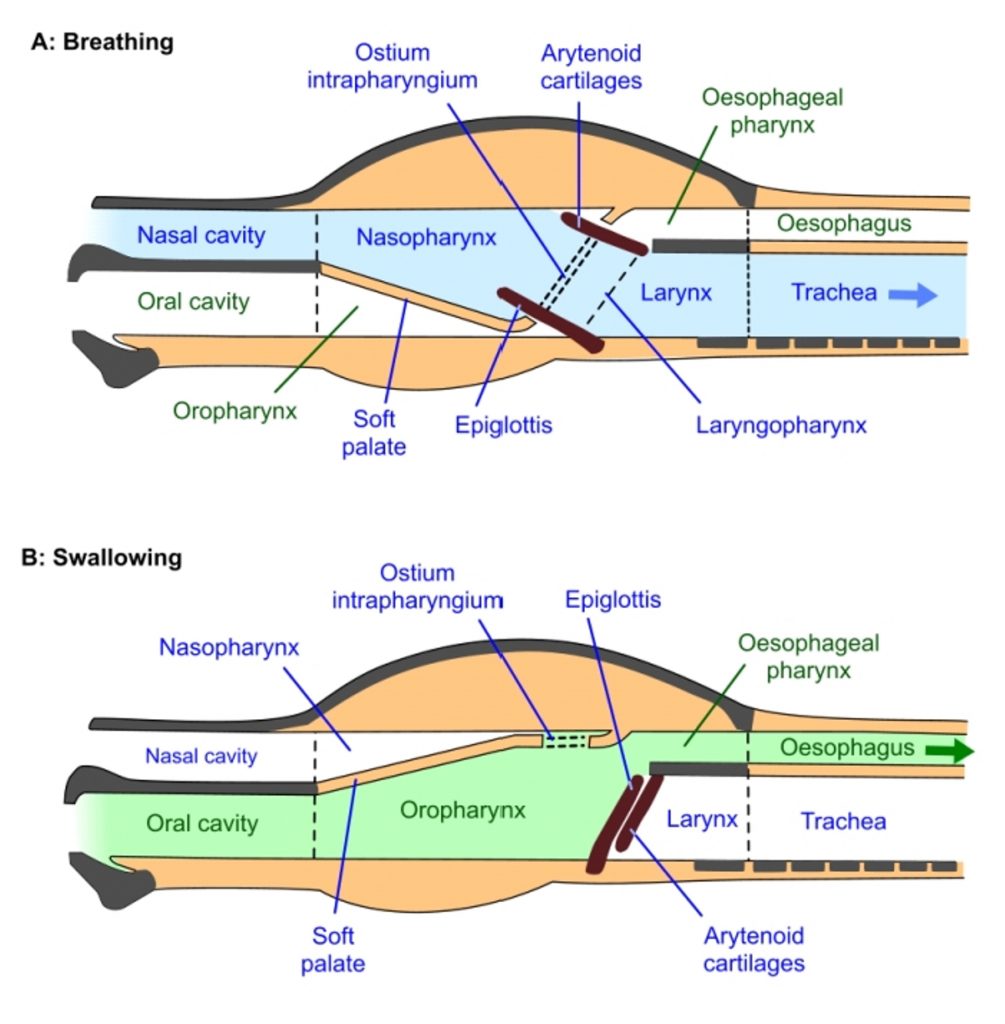
You can learn about the bitted horse’s physiological plight by carrying out a breathing test on yourself. But first, let’s similarly address the question of bit-induced pain. Follow the steps in Fig.2 of a test used by a leading animal welfare scientist, David Mellor (Personal communication 2018), at his presentations, “Equine welfare during exercise: Do we have a ‘bit’ of a problem?” (Mellor, 2019a and b) As he says when introducing the test, “Rein tension transferred to the bit in contact with the gums at the bars of the mouth causes pain. Gums are exquisitely sensitive to painful stimuli, including pressure.”

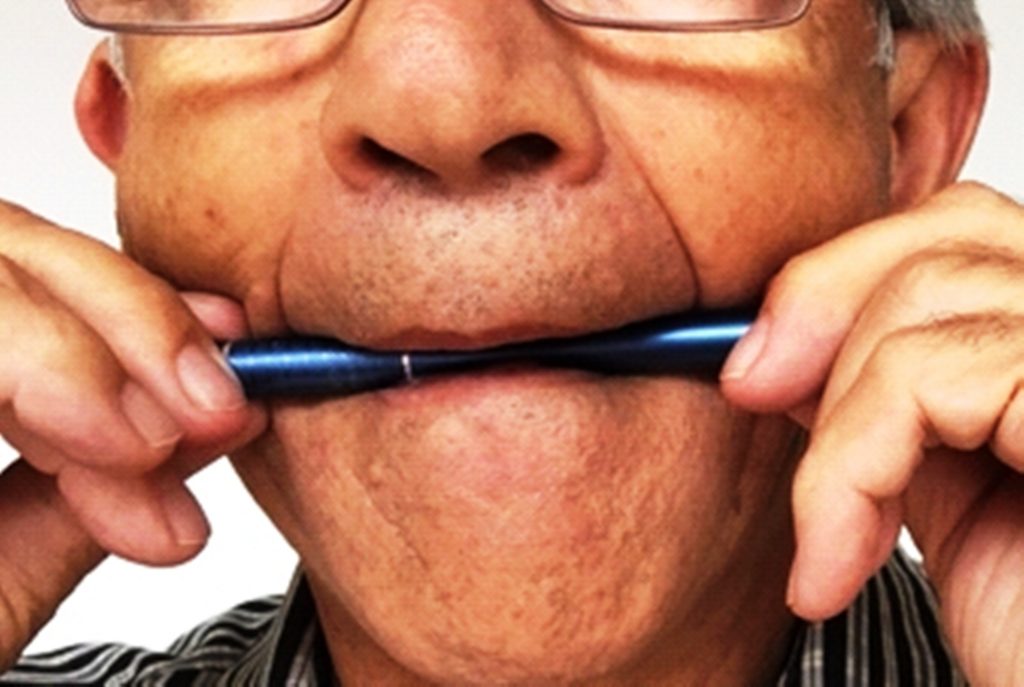
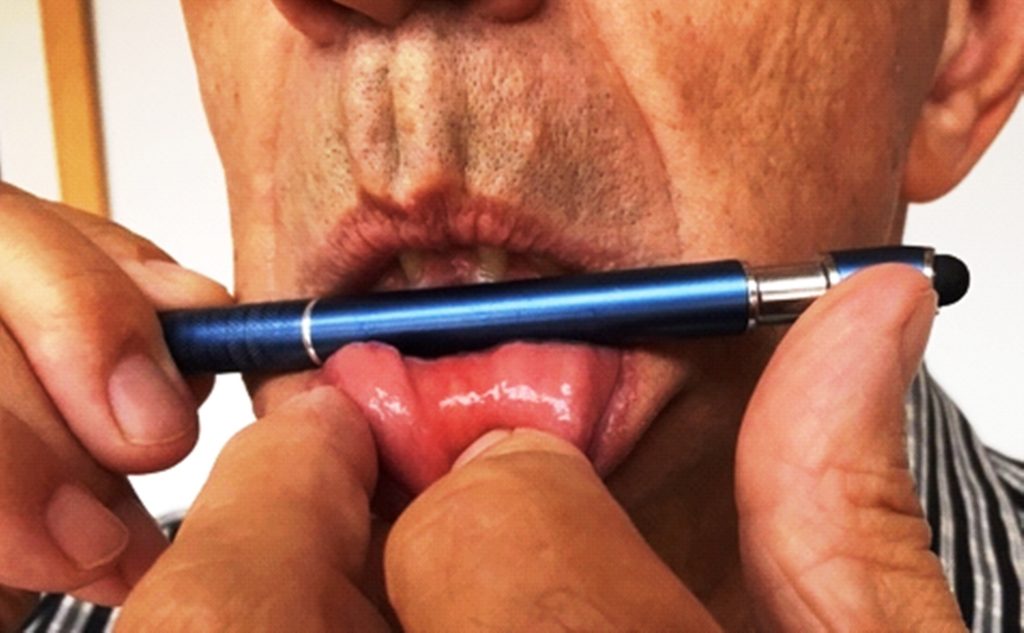
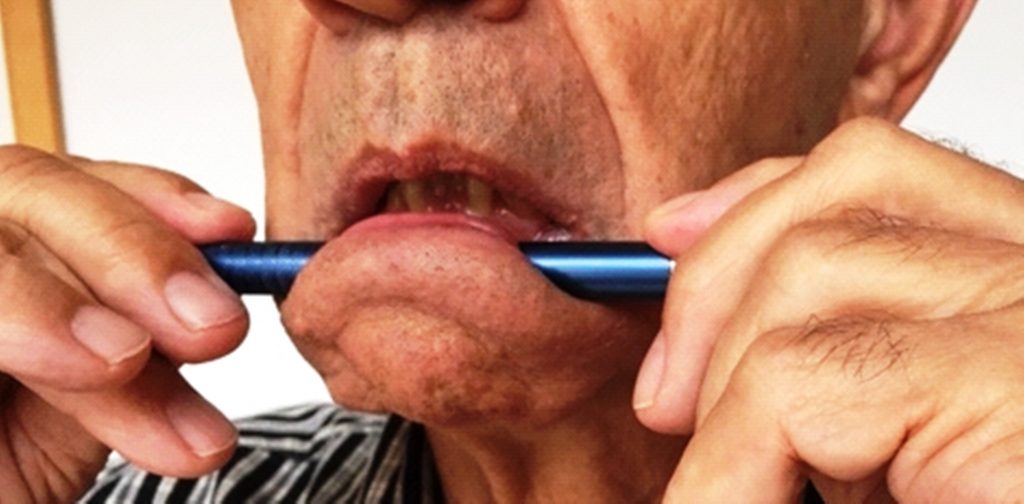
Did even slight pressure hurt? Did you grimace? Did you have the courage to use moderate or severe pressure? Would you ‘play horse’ and invite a small child to sit on your back when holding string reins attached to each end of the pen? Slight pressure will correspond to that degree of ‘contact’ recommended by dressage federations and severe pressure to those times in other circumstances when reins are used for abrupt deceleration or changes of direction. A racehorse being ‘rated’ (held-in during a race) will experience severe pain that continues until bit pressure is ‘released’ in the final-stretch run.
Now return to Position 2. With your mouth open wide, push the pen firmly towards the back of the throat until your lips will stretch no further. Hold the pen in this position for 5 seconds.
This will have been painful. I apologize. But, over and above pain from the bars of the mouth, this is what a bitted horse often endures for much longer periods, when his lips are stretched to twice their resting length by rein tension.
Now repeat the stretching once more but, at maximum stretch, bite down on the pen and hold it between your teeth. Does this lessen the discomfort? And did you partially close your mouth? Congratulations! You have just simulated a horse with “the bit between his teeth” defending himself from pain and, incidentally, depriving the rider of any rein-aid communication.
Gum on the bars of the mouth is the specialized ‘skin’ of the jawbone. Think of it as ‘soft’ bone. Though a few skillful riders can, much of the time, use a bitted rein with infinitely transient and close-to-zero bit-pressure, the average rider does not have this ability. A bit does not control a horse. On the contrary, in my experience a bit is the most common cause of complete loss of control. Bit-induced pain is overkill and a barrier to communication.
For a rider to communicate successfully with a horse it is imperative to avoid hurting him. Pain is contraindicated. A horse in pain cannot ‘listen’ and is slow to learn. Horses express their discomfort with a bewildering number of behaviors that, collectively, are often – and unreasonably – labeled as flaws in a horse’s character, e.g., “my horse is …uncooperative, bossy, argumentative, hard-mouthed, anxious, spooky”, etc. Some horses are characterized as being excitable and ‘too forward,’ whereas others are blamed for being ‘lazy, sluggish and poor performers’ (e.g., exhibiting learned helplessness). Head tossing in some respects seems to be the horse equivalent of our grimace reflex. A study of 69 ‘unwanted’ behaviors (i.e., pain indices) in 66 horses showed that removal of the bit reduced the total number of pain indices in the population from 1575 to 208, a reduction of 87% (Cook and Kibler 2018). Thus, a bit appears to be a gratuitous handicap to both horse and rider.
Now to the breathing test.
- Breathe deeply, as when exercising.
- Breathe in and out through your mouth.
- Ask yourself, am I – when mouth-breathing – also moving air in and out of my nose?
- I can anticipate that your answer to that question will be – ‘No’
- Continue to breathe deeply, but now breathe in and out through your nose
- What changes did you make in order to do this?
- Again, you will have closed your mouth and firmly sealed your lips
- Did you make any other change? Try again and take note.
- You now realize that in addition to sealing your lips, you instinctively placed your tongue firmly against the roof of your mouth. It’s as though the digestive tract is closed with a double lock; lips and tongue.
- Repeat the step again and ask yourself if any other changes occur when you switch from mouth to nose-breathing.
- You may now be aware that you flare your nostrils, elevate and stretch your lips.
- Continue to breathe deeply and see if you can nose-breathe with your lips sealed but with the tip of your tongue on the floor of your mouth
- What was the sensation that made you aware that it was a little more difficult to breathe?
- My guess is that, at each intake of air, you will have sensed a partial closure of the airway in your throat
- Repeat step five; breathe deeply through your nose with your mouth closed and lips sealed.
- Continue breathing deeply but open your mouth, keeping your tongue on the floor of the mouth. Try to flare your nostrils.
- As before, you will now be mouth-breathing not nose-breathing. Note also that in order to flare your nostrils a conscious effort is needed and it is quite difficult to do. Even when your nostrils are flared, nose-breathing still does not occur.
- Keeping your mouth open, now breathe deeply with your tongue against the roof of your mouth
- Although your mouth was open, this allowed you to nose-breathe.
- But did you notice a tendency for your nostrils to collapse at each intake of breath?
What is the relevance of all this to a horse? Well, while we humans have the option to either nose- or mouth-breath, a horse does not. A horse is an obligate nose-breather and cannot mouth-breathe. The horse has a much longer soft palate and, unlike us, the rear-end of a horse’s soft palate has an elastic-sided button-hole that fastens it securely (when breathing deeply) to the ‘button’ at the top of the windpipe, i.e., the voice-box or larynx (Fig 1). In addition, immediately before starting to run, a horse at liberty will close his lips and swallow. This serves the critical purpose of switching him instantly from, primarily, a digestive mode to an exclusive respiratory mode. It creates a negative pressure in the oropharynx which holds the whole of the soft palate firmly in contact with the immobile root of tongue and the outer rim of the voice box. This air-tight apposition is one of three critical conditions that a horse needs to ensure the integrity of its airway to support running.
Even if a bitted horse succeeds in creating a partial vacuum in his mouth when still stationary, the moment before an anticipated run, any pressure on the bit during the run is likely to break the lip-seal and dissipate the vacuum. It only takes a very small hole to do this, so the gap will not necessarily be visible. Without the vacuum, a horse begins to suffocate. The soft palate will ‘blow and balloon’ like a blanket in the wind at each intake of breath, elevating and obstructing the throat airway (nasopharynx).
A bit also obstructs the airway in two other ways. First, rein tension and bit pain enable a rider to prevent a horse from stretching out its head and neck at the gallop (e.g., as when a racehorse is rated). Poll flexion constricts the airway. Secondly, a bit stimulates salivation followed by swallowing, which interferes with breathing, as does any movement of the tongue, jaw or head to evade the bit (Fig. 1B). Saliva may be inhaled.
In the racehorse particularly, but not exclusively, death can follow from a cascade of consequences from these three restrictive factors, namely, asphyxia, negative pressure pulmonary edema (‘waterlogging of the lung’, aka exercise-induced pulmonary hemorrhage or ‘bleeding’) and heart failure. A second scenario is that airway obstruction leads to premature fatigue, exhaustion, stumbles, breakdowns, falls and fractures. A third scenario is that chest pain and a sense of drowning (as with pulmonary edema in man) causes poor performance.
A horse probably breathes better through his nose, as we do, by placing his tongue against the roof of his mouth. If a bitted horse wants to do this, he must first put his tongue over the bit. By so doing he markedly hinders any rein-aided communication. The end result of ‘tongue over bit’ is probably also prompted by tongue pain. When trapped under the bit, the tongue – an exquisitely sensitive organ – is likely to be pinched between the bit and the bars of the mouth, the top edges of which are almost a sharp as a knife. To avoid this, a horse will retract his tongue behind the bit. Unfortunately, by solving one problem he creates others.
The horse’s tongue, like our own, has the physical property of a muscular hydrostat. At physiological pressures, water is incompressible. Muscle being mainly water, the tongue acts like a water-filled bag. A decrease in volume in any part of the tongue results in an equivalent increase in volume in some other part. Accordingly, a muscular shortening of the tongue’s tip results in a bulging upwards of the tongue’s root in the back of the throat. This elevates the soft palate and narrows the throat airway. Finding it difficult to breathe, the horse will now extend the tongue forward; again ‘tongue over bit’. From the horse’s point of view this is still not a satisfactory solution because now the bit will be pressing directly on bone, the bars of the mouth. The pain may be severe but he must breathe. Faced with a choice between suffocation or pain, he will choose to draw his breath in pain, at least for a while. There is, of course, the possibility that with persistent pain he may fight back by rearing, bucking or, in blind panic, bolting. Accidents on the racetrack and elsewhere may be caused by an uncontrollable horse that is no longer fully conscious.
In sum, this is your horse’s advice:
“If you want me to behave, don’t hurt me.
If you want me to perform well, don’t put a bit in my mouth.
A bit can be the death of me.”
Further reading (all ‘open access’)
Mellor, D.J. and Beausoleil, N.J. (2017): Equine welfare during exercise: An evaluation of breathing, breathlessness and bridles. Animals. 7, 41 http://www.mdpi.com/2076-2615/7/6/41
Mellor, D.J. (2019a): Equine welfare during exercise 1. Do we have a bit of a problem
Mellopr, D.J. (2019b): Equine welfare during exercise 2. Do we have a bit of a problem
Cook, W.R. and Kibler, M.L (2018): Behavioural assessment of pain in 66 horses, with and without a bit. Equine Veterinary Education. https://doi.org/10.1111/eve.12916
Cook, W.R. (2019). Horsemanship’s ‘elephant-in-the-room’ – The bit as a cause of unsolved problems affecting both horse and rider. Weltexpress: https://en.weltexpress.info/2019/02/15/horsemanships-elephant-in-the-room-the-bit-as-a-cause-of-unsolved-problems-affecting-both-horse-and-rider/



